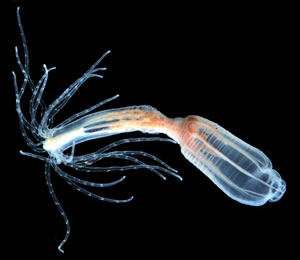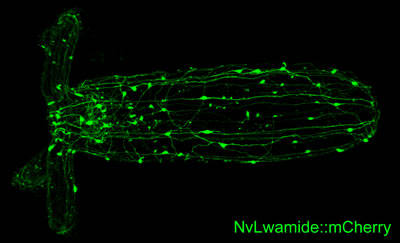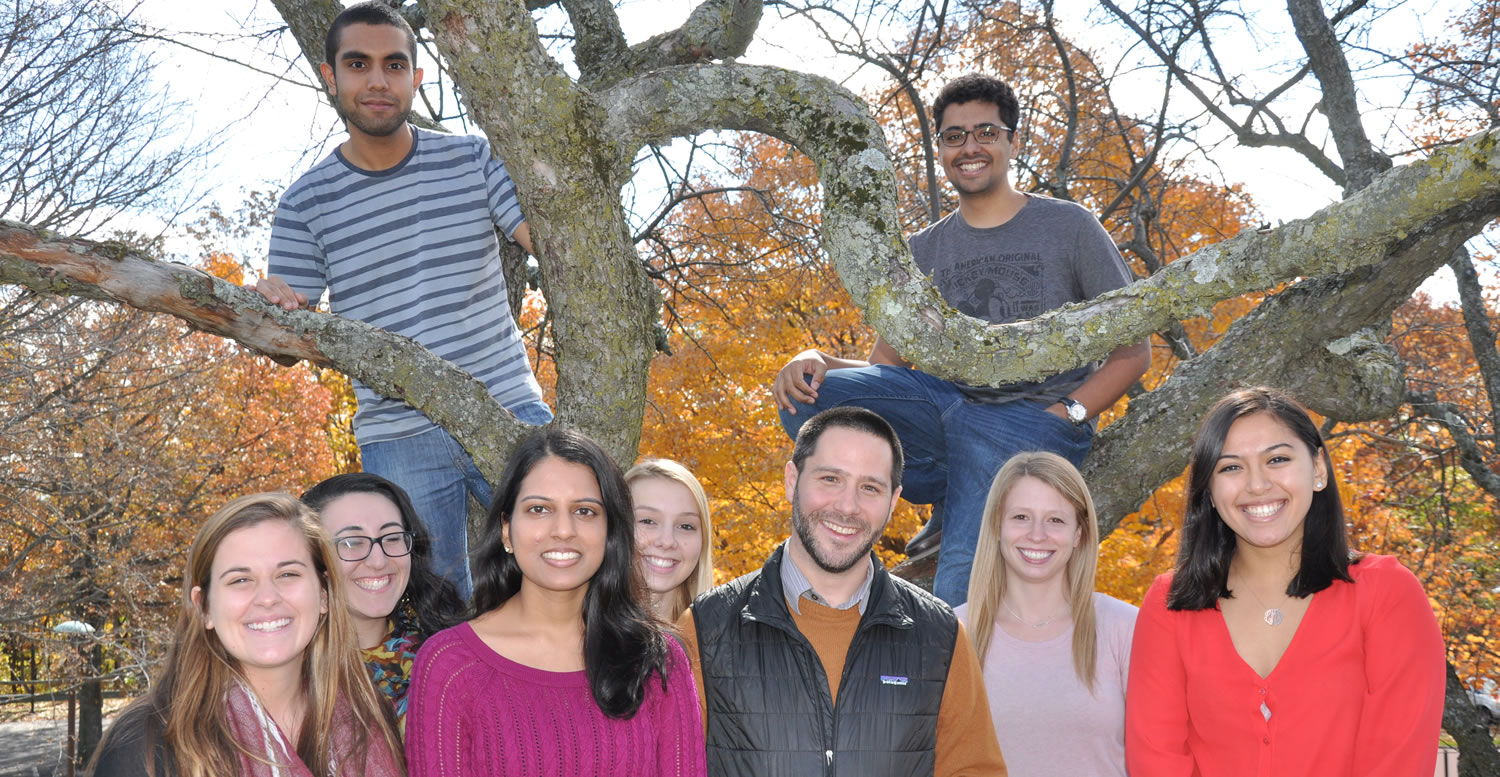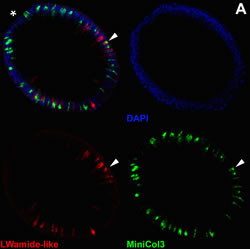 |
| Nematostella vectensis |
Primary interests:
- Identifying and understanding the mechanisms that regulate neural development and regeneration.
- Understanding the evolution of nervous systems by comparing the developmental mechanisms that regulate nervous system formation in extant taxa.
The Layden Lab studies neural development in the sea anemone Nematostella vectensis. Nematostella is an emerging system that is important, because it is a robust model for studying mechanisms that regulate neurogenesis during development and regeneration. Understanding the similarities and differences in how developmental programs are redeployed during regeneration will provide critical clues necessary to better design regenerative therapies for biomedical applications.
Nematostella is also a cnidarian animal that possesses a nerve net rather than a central nervous system. Cnidarians (jellyfish, corals, sea anemones, hydras) are a phylogenetically pivotal group of animals, because they are the closest relatives to the bilaterians (insects, annelids, mollusks, sea urchin, vertebrates). One characteristic of most bilaterians is the presence of a centralized nervous system. By investigating neurogenesis in cnidarians we can infer the ancestral mechanisms that gave rise to and perhaps evolutionary origin of the bilaterian central nervous system(s).
 |
| Embryo stained with neural marker |
1. Characterizing the role of the neurogenic transcription factor NvashA during development and regeneration.
Fluorescent double in situ labeling cnidocyte stinging cells (green), neuronal marker (red),
and nuclei (blue)NvashA regulates formation of a subset of the Nematostella nervous system during embyrogenesis. We will continue to disrupt NvashA function and assay neural phenotypes at larval and juvenile polyp stages. In conjunction with this we are improving approaches to disrupt NvashA function during regeneration. The goal is to assay whether NvashA regulates formation of the same neurons that it does during development, regulates neural development using the exact same molecular program, and/or regulates distinct neuron sub-types that are not regulated by NvashA during development.
2. Characterizing transgenic lines
As part of our work investigating NvashA we have generated a number of transgenic lines. We are in the process of characterizing the types of neurons described by the transgenic lines, mapping the projections from each neuronal type, and describing re-development of neurons labeled by transgenic reporters during regeneration.
3. Investigating the evolution of Notch signaling as a regulator of neural development.
We recently reported about the role of Notch signaling as a regulator of neural differentiation, and in particular of its role regulating NvashA-dependent neurogenesis. We found some key differences between Notch signaling in Nematostella and in bilaterians. Current work aims to better understand the molecular mechanism by which Notch regulates neurogenesis in cnidarians in order to better understand the evolution of Notch signaling and neural differentiation.
 |
| Transgenic line labeling subset of Nematostella nervous system |
*denotes with Lehigh affiliation
 Layden, M. J., Rentzsch, F., & Röttinger, E. (2016). The rise of the starlet sea anemone Nematostella vectensis as a model system to investigate development and regeneration. Wiley Interdisciplinary Reviews: Developmental Biology, 1–21. doi: 10.1002/wdev.222
Layden, M. J., Rentzsch, F., & Röttinger, E. (2016). The rise of the starlet sea anemone Nematostella vectensis as a model system to investigate development and regeneration. Wiley Interdisciplinary Reviews: Developmental Biology, 1–21. doi: 10.1002/wdev.222
 Layden, M. J., Johnston, H., Amiel, A. R., Havrilak, J., Steinworth, B., Chock, T., et al. (2016). MAPK signaling is necessary for neurogenesis in Nematostella vectensis. BMC Biology, 1–19. doi: 10.1186/s12915-016-0282-1
Layden, M. J., Johnston, H., Amiel, A. R., Havrilak, J., Steinworth, B., Chock, T., et al. (2016). MAPK signaling is necessary for neurogenesis in Nematostella vectensis. BMC Biology, 1–19. doi: 10.1186/s12915-016-0282-1
 Rentzsch, F., Layden, M., & Manuel, M. (2016). The cellular and molecular basis of cnidarian neurogenesis. Wiley Interdisciplinary Reviews: Developmental Biology, 1–19. doi: 10.1002/wdev.257
Rentzsch, F., Layden, M., & Manuel, M. (2016). The cellular and molecular basis of cnidarian neurogenesis. Wiley Interdisciplinary Reviews: Developmental Biology, 1–19. doi: 10.1002/wdev.257
 *Li, X., Martinson, A., Layden, M.J., Diatta, F., Sberna, A., Simmons, D., Martindale, M., Jegla, T. 2015. Ehter-a-go-go family voltage-gated K+ channels evolved in an ancestral metazoan and functionally diversified in a cnidarian-bilaterian ancestor. Journal of Experimental Biology. 218, 526-536 doi: 10.1242/jeb. 110080.
*Li, X., Martinson, A., Layden, M.J., Diatta, F., Sberna, A., Simmons, D., Martindale, M., Jegla, T. 2015. Ehter-a-go-go family voltage-gated K+ channels evolved in an ancestral metazoan and functionally diversified in a cnidarian-bilaterian ancestor. Journal of Experimental Biology. 218, 526-536 doi: 10.1242/jeb. 110080.
 *Baker, E., Layden, M.J. van Rossum, D., Kael, B., Medina, M., Simpson, E., Jegla, T. 2015. Functional Characterization of Cnidarian HCN Channels Points to an Early Evolution of Ih. PLOS One. DOI: 10.1371/journal.poine.0142730.
*Baker, E., Layden, M.J. van Rossum, D., Kael, B., Medina, M., Simpson, E., Jegla, T. 2015. Functional Characterization of Cnidarian HCN Channels Points to an Early Evolution of Ih. PLOS One. DOI: 10.1371/journal.poine.0142730.
 *Layden, M.J., Martindale, M.Q., (2014) Non-canonical Notch signaling represents an ancestral mechanism to regulate neural differentiation. EvoDevo, 5:30 doi:10.1186/2041-9139-5-30
*Layden, M.J., Martindale, M.Q., (2014) Non-canonical Notch signaling represents an ancestral mechanism to regulate neural differentiation. EvoDevo, 5:30 doi:10.1186/2041-9139-5-30
 Heckscher, E., Long, F., Layden, M.J., Chuang, C., Manning, L., Richart, J., Pearson J.C., Crews, S.T., Peng, H., Myers, E., Doe, C.Q., (2014) Atlas-builder software and the eNeuro atlas: resources for developmental biology and neuroscience. Development, doi:10.1242/dev.108720
Heckscher, E., Long, F., Layden, M.J., Chuang, C., Manning, L., Richart, J., Pearson J.C., Crews, S.T., Peng, H., Myers, E., Doe, C.Q., (2014) Atlas-builder software and the eNeuro atlas: resources for developmental biology and neuroscience. Development, doi:10.1242/dev.108720
 Martinson, A.P., van Rossum, D.B., Diatta, F.H., Layden, M.J., Rhodes, S.A., Martindale, M.Q., Jegla, T., (2014) Functional evolution of Erg Potassium Channel Gating reveals an ancient origin for IKr. PNAS doi:10.1073/pnas.1321716111
Martinson, A.P., van Rossum, D.B., Diatta, F.H., Layden, M.J., Rhodes, S.A., Martindale, M.Q., Jegla, T., (2014) Functional evolution of Erg Potassium Channel Gating reveals an ancient origin for IKr. PNAS doi:10.1073/pnas.1321716111
 Layden, M.J., Wolenski, F.S., Roettinger, E, Gilmore, T.D., Martindale, M.Q., (2013) Microinjection of mRNA or morpholinos for reverse genetic analysis in the starlet sea anemone, Nematostella vecentsis. Nature Protocols 8: 924-34 doi: 10.1038/nprot.2013.009
Layden, M.J., Wolenski, F.S., Roettinger, E, Gilmore, T.D., Martindale, M.Q., (2013) Microinjection of mRNA or morpholinos for reverse genetic analysis in the starlet sea anemone, Nematostella vecentsis. Nature Protocols 8: 924-34 doi: 10.1038/nprot.2013.009
 Wolenski, F.S., Layden, M.J., Martindale, M.Q., Gilmore T.D., Finnerty, J.R., (2013) Characterizing the spatiotemporal expression of RNAs and proteins in the starlet sea anemone, Nematostella vectensis. Nature Protocols 8: 900-15 doi: 10.1038/nprot.2013.014
Wolenski, F.S., Layden, M.J., Martindale, M.Q., Gilmore T.D., Finnerty, J.R., (2013) Characterizing the spatiotemporal expression of RNAs and proteins in the starlet sea anemone, Nematostella vectensis. Nature Protocols 8: 900-15 doi: 10.1038/nprot.2013.014
 Reitzel, A.M., Herrera, S., Layden, M.J., Martindale, M.Q., Shank, T.M., (2013) Going where traditional markers have not gone before: utility of and promise for RAD-sequencing in marine invertebrate phylogeography and population genomics. Molecular Ecology doi: 10.1111/mec.12228
Reitzel, A.M., Herrera, S., Layden, M.J., Martindale, M.Q., Shank, T.M., (2013) Going where traditional markers have not gone before: utility of and promise for RAD-sequencing in marine invertebrate phylogeography and population genomics. Molecular Ecology doi: 10.1111/mec.12228
 *Layden, M.J., Boekhout, M., Martindale, M.Q. (2012) Nematostella vectensis achaete-scute homolog NvashA regulates embryonic ectodermal neurogenesis and represents an ancient component of the metazoan neural specification pathway. Development 139: 1013-22 doi: 10.1242/dev.073221
*Layden, M.J., Boekhout, M., Martindale, M.Q. (2012) Nematostella vectensis achaete-scute homolog NvashA regulates embryonic ectodermal neurogenesis and represents an ancient component of the metazoan neural specification pathway. Development 139: 1013-22 doi: 10.1242/dev.073221
Layden, M.J., Meyer, N.P., Pang, K., Seaver E.C., Martindale, M.Q. (2010), Expression and phylogenetic analysis of the zic gene family in the evolution and development of metazoans. EvoDevo, 1:12
Layden, M.J., Odden, J.P., Schmid, A., Garces, A., Thor, S., Doe, C.Q. (2005). Zfh1, a somatic motor neuron transcription factor, regulates axon exit from the CNS. Developmental Biology, 291(2): 253-63.
 Cheesman, S.E., Layden, M.J., Von Ohlen, T., Doe, C.Q., Eisen, J.S. (2004). Zebrafish and
Cheesman, S.E., Layden, M.J., Von Ohlen, T., Doe, C.Q., Eisen, J.S. (2004). Zebrafish and
fly Nkx6 proteins have similar CNS expression patterns and regulate motoneuron formation. Development, 131(21): 5221-5232.
Hagen FK, Layden M, Nehrke K, Gentile K, Berbach K, Tsao CC, Forsythe M (2001) Mucin-type O-Glycosylation in C. elegans is initiated by a family of glycosyltransferases. TIGG, 13:463-479.

Layden Lab - 2015
top row: Suraj Pursnani, Dylan Faltine-Gonzalez
bottom row: Courtney Turiano, Daniella Fodera, Nisha Singh, Alexandra Mease, MMichael Layden, Ph.D., Jamie Havrilak, Ph.D., Caitlin Tedeschi
Postdoctoral Researchers
Jamie Havrilak
My research interests involve studying how cellular interactions during development regulate organogenesis. I would like to understand how signaling pathways interact and regulate crosstalk between cells to drive specification, differentiation and morphogenesis. In particular I am interested in understanding the mechanisms that regulate nervous system development in the starlet sea anemone Nematostella vectensis, and how these mechanisms differ from those utilized during regeneration. My project is currently examining achaete-scute- and atonal-like genes and their roles during development and regeneration.
Graduate Students
Dylan Faltine-Gonzalez
I’m interested in understanding the evolution of bilateral nervous systems and regeneration within the starlet sea anemone, Nematostella vectensis. I am specifically interested in determining whether the pathways for neurogenesis during development and regeneration are identical. My current project focuses on the transcription factor NvashA, which has been previously found to regulate early neurogenesis of a specific subset of neurons. I am currently investigating the role NvashA plays throughout development and at different stages of regeneration
Undergraduate Researchers
Suraj Pursnani
I am currently a junior at Lehigh University, majoring in molecular biology and minoring in Health, Medicine, and Society. One component of my research is understanding how neurons differentiate from naïve proliferative cells. Notch-Delta signaling is a well-known and a highly conserved signaling pathway that regulates cellular differentiation in animals. My research focuses on Delta signaling and we hypothesize that Delta plays an active role in promoting cellular differentiation.
Nisha Singh
I am a junior majoring in molecular biology. My research focuses on the analysis of neural regulatory genes within the achaete-scute homolog (ash) family in the sea anemone Nematostella vectensis. These genes play important roles in neural development and regeneration. They may also reveal key details about the evolution of neural regulatory systems. I aim to better characterize the functionality, scope, and specificity of the Ash genes with the hopes of contributing to a more comprehensive evolutionary understanding of neural regulation.
Caitlin Tedeschi
I am a sophomore majoring in behavioral neuroscience. My research focuses on characterizing the expression patterns of Atonal-related genes during development and regeneration within the model organism Neatostella vectensis. I plan to help identify their genetic expression within the organism and conduct functional studies to determine their role in neural development.
Courtney Touriano
I am interested in Delta-Notch signaling. Specifically, I will be looking to see what genes are down regulated in response to Delta signaling and how those genes might regulate neural differentiation in Nematostella vectensis.
Work Study Students
Daniella Fodera
Alexandra Mease



